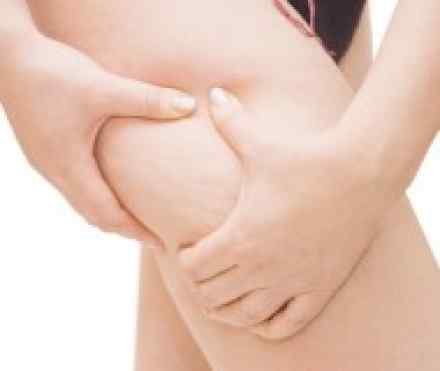
What is it?
- Most women have cellulite — fat that appears as dimpled skin on their thighs, hips and buttocks. Though not a serious medical condition, cellulite can be unsightly, and it may make you self-conscious when wearing shorts or a swimming suit.
- Many cellulite treatments, including massages or cellulite creams, advertise remarkable results. But unfortunately, most of these treatments don't live up to their claims. So is there anything you can do about cellulite?
Symptoms
Cellulite looks like dimpled or bumpy skin. It's sometimes described as skin with a cottage cheese or orange-peel texture. Cellulite ranges in severity. Mild cases can only be seen when the skin is pinched — the dimpling appears in the pinched skin. More-severe cases make the skin appear rumpled and bumpy with areas of peaks and valleys.
Causes
Cellulite is caused by fibrous connective cords that connect the skin to the underlying muscle. The cords tether the skin to deeper structures, with the fat lying in between. As the fat cells accumulate, they push up against the skin, while the long, tough cords are pulling down. This creates an uneven surface or dimpling.
Risk factors
Cellulite is much more common in women than in men. In fact, the majority of women — at least eight out of 10 — have some degree of cellulite. This is because fat is typically distributed in women in the thighs, hips and buttocks — common areas for cellulite. In addition, cellulite is more common with aging, when the skin loses some of its elasticity.
Weight gain can make cellulite more noticeable, but cellulite may still be present in lean individuals. It tends to run in families, so genetics may play the biggest role in whether you develop cellulite.
Other factors that may increase your chances of having cellulite include:
Treatments and drugs
Weight loss
Weight loss — through healthy diet and regular exercise — is probably the most beneficial cellulite treatment. Losing pounds and strengthening muscles in your legs, thighs and buttocks can improve the appearance of the dimpled skin. The benefits of weight loss alone are limited, however. Though the cellulite may be less noticeable after weight loss, it won't go away completely.
Lasers and radiofrequency systemsPerhaps the most promising medical therapy is lasers and radiofrequency systems. One system uses combined negative tissue massage, radiofrequency and infrared light to treat cellulite. The other system delivers combined tissue massage with diode laser energy. Both systems offer improvements to cellulite after a series of several twice-weekly treatments. Results may last up to six months.
Liposuction ineffective
Some people may turn to liposuction as a treatment for cellulite. During liposuction, a surgeon inserts a narrow tube under your skin through tiny incisions, and then suctions out fat cells. Though liposuction can shape the body, it won't remove cellulite, and it may make the cellulite appear worse.
Alternative medicine
Many devices, products and creams claim to treat cellulite. But there is little or no scientific evidence to support these claims. If you do find a cellulite treatment that improves your skin, the results aren't likely to last long term.
The following are a few of the many advertised cellulite treatments. Keep in mind that these treatments haven't been proved effective in removing cellulite.
- Vigorous massage. Some cellulite treatments are based on the concept that vigorous massage will increase blood flow, remove toxins and reduce excess fluid in cellulite-prone areas. One method in particular, Endermologie (also referred to as lipomassage), uses a hand-held machine to knead the skin between rollers. You may notice a slight improvement to your skin after this treatment, but the results are typically short-lived.
- Mesotherapy. This procedure involves injecting a solution — which may contain a combination of aminophylline, hormones, enzymes, herbal extracts, vitamins and minerals — under the skin. This treatment can cause several unwanted effects, including infection, rashes, and bumpy or uneven skin contours.
- Cellulite creams. Creams that contain a variety of ingredients, such as vitamins, minerals, herbal extracts and antioxidants, are often marketed as the cure for cellulite. But no studies show that these creams offer any improvement. And in some cases, the ingredients in these products cause skin reactions or rashes.
Prevention
There is no way to prevent getting cellulite. Keeping off excess pounds and strengthening your muscles through regular exercise, however, can go a long way toward maintaining your skin tone and texture.
References:
https://www.nlm.nih.gov/medlineplus/ency/article/002033.htm
https://en.wikipedia.org/wiki/Cellulite
http://www.health.com/health/gallery/0,,20735356,00.html
http://www.medicinenet.com/cellulite/article.htm
http://www.prevention.com/fitness/strength-training/6-moves-target-cellulite

